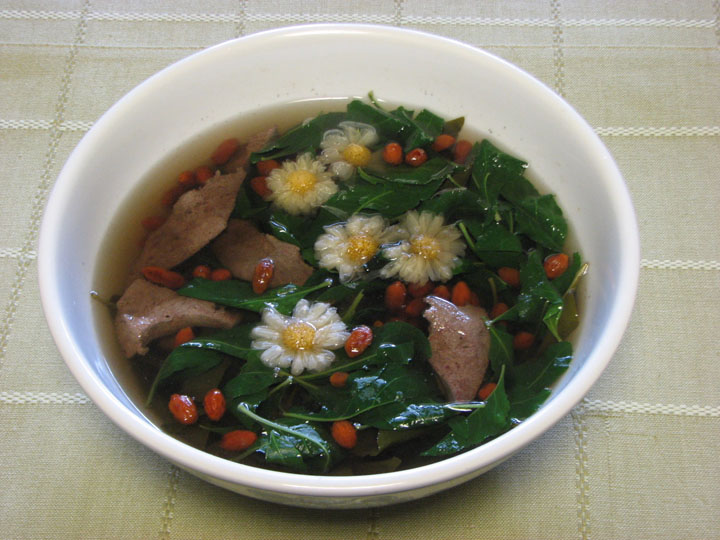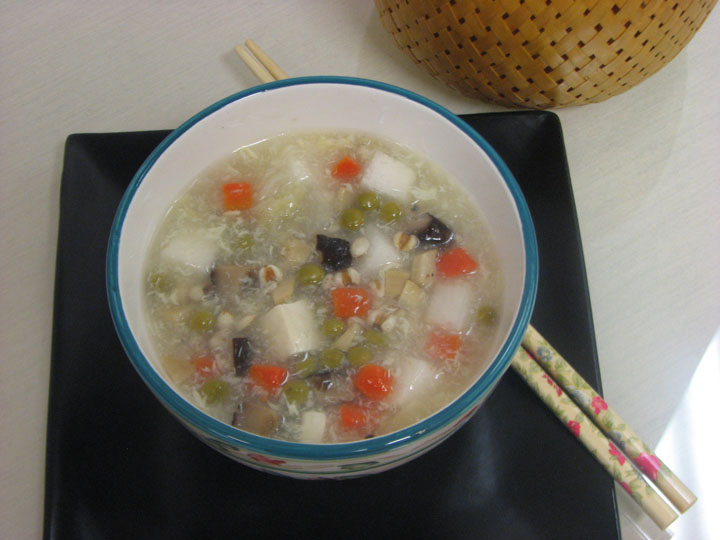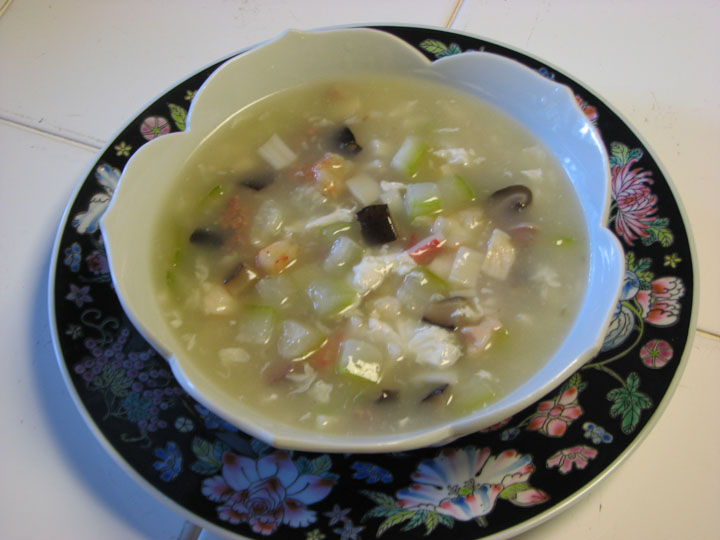
| What is Flavor and Fortune? |
| How do I subscribe? |
| How do I get past issues? |
| How do I advertise? |
| How do I contact the editor? |
Read 13011552 times
Connect me to:
| Home |
| Articles |
| Book reviews |
| Letters to the Editor |
| Newmans News and Notes |
| Recipes |
| Restaurant reviews |
| Article Index (all years, slow) |
| List of Article Years |
| Article Index (2025) |
| Article Index (last 2 years) |
| Things others say |
| Related Links |
| Log In... |
| Authors |
| Categories & Topics |
Way of Soup, The
| by Teresa M. Chen |
Soups and Congees
Spring Volume: 2010 Issue: 17(1) page(s): 5, 6, and 18
CANTONESE SOUP TRADITIONS are primarily those of the Pearl River Delta. They explicitly link food to health and healing. Soup is a beverage, a tonic, and a source of nourishment. Soup can also be a way of administering natural medicine in a most delightful way.
 Most Cantonese households prepare daily soups appropriate to the season, the weather, the occasion, and perceived health needs. Restaurants present soups addressing a whole array of health intentions. I use the term 'health intention' instead of 'health claim' to avoid confusion with symptom-oriented medication. In fact, no one needs to be sick to share delicious soups. Almost all Cantonese daily soups, including those with medicinal herbs, may be served to the entire family for health maintenance. Soup is the kind of food that is both healing and preventive.
Most Cantonese households prepare daily soups appropriate to the season, the weather, the occasion, and perceived health needs. Restaurants present soups addressing a whole array of health intentions. I use the term 'health intention' instead of 'health claim' to avoid confusion with symptom-oriented medication. In fact, no one needs to be sick to share delicious soups. Almost all Cantonese daily soups, including those with medicinal herbs, may be served to the entire family for health maintenance. Soup is the kind of food that is both healing and preventive.
 One does not have to have a cold to partake of a soup made with ginger, green onion, fermented black beans, and tofu. One does not have to be anemic to drink a soup made with pork liver and lycii leaves. One does not have to be a nursing mother to enjoy a fish tail soup cooked with papaya and peanuts. One does do not even have to be a woman to benefit from a Dang Gui and Chicken Soup. Everyone benefits from a soup that dispels wind in spring, dampness and heat in summer, dryness in autumn, and chill in winter.
One does not have to have a cold to partake of a soup made with ginger, green onion, fermented black beans, and tofu. One does not have to be anemic to drink a soup made with pork liver and lycii leaves. One does not have to be a nursing mother to enjoy a fish tail soup cooked with papaya and peanuts. One does do not even have to be a woman to benefit from a Dang Gui and Chicken Soup. Everyone benefits from a soup that dispels wind in spring, dampness and heat in summer, dryness in autumn, and chill in winter.
Cooked ingredients in soups are easily digestible. Water soluble vitamins are readily available. Our spleen and stomach will not have to work as hard as tackling raw food and cold drinks. Soup is the Cantonese way to 'harness the power of nature, to heal common ailments, boost...vitality, and achieve optimum wellness,' to borrow the eloquent words from the subtitle of Dr. Maoshing Ni's book, ther Secrets of Self-Healing.
 On a recent trip to China's Pearl River Delta with Chef Martin Yan, our group sampled three 'medicinal' soups at each of the two top regional restaurants specializing in soups, namely, Tou Dan Tang in Guangzhou and A Er Liang Tang in Shunde. The soups are labeled 'medicinal' because herbs such as tuckahoe, agrimony, and reishi mushroom are used. Other ingredients such as fish, pork, fuzzy melon, lotus seeds, and pumpkin also offer 'medicinal' benefits, according to traditional Chinese medicine (TCM). Both food and medicine are characterized by a similar taxonomy in TCM terms. Food is medicine and medicine is food. If you accept the additional requirement for food to taste good, food becomes medicine at its best.
On a recent trip to China's Pearl River Delta with Chef Martin Yan, our group sampled three 'medicinal' soups at each of the two top regional restaurants specializing in soups, namely, Tou Dan Tang in Guangzhou and A Er Liang Tang in Shunde. The soups are labeled 'medicinal' because herbs such as tuckahoe, agrimony, and reishi mushroom are used. Other ingredients such as fish, pork, fuzzy melon, lotus seeds, and pumpkin also offer 'medicinal' benefits, according to traditional Chinese medicine (TCM). Both food and medicine are characterized by a similar taxonomy in TCM terms. Food is medicine and medicine is food. If you accept the additional requirement for food to taste good, food becomes medicine at its best.
BOILING WATER in this case has to do with the Chinese character for soup, tang, because it means boiling water. Boiling has always been a very effective way for sanitizing water and food. To a pot of boiling water one may add tea leaves, edible flowers, vegetables, grains, legumes, nuts and seeds, sea vegetables, fungi, medicinal herbs, meat, poultry and eggs, fish, shellfish, food products, and any combination thereof (barring incompatibility) to make soups with varying proportions of solid and liquid. Needless to say, people need water to quench their thirst. Water constitutes sixty to sixty-five percent of the human body. People have to drink plenty of fluid to sustain life; even when fasting, people need to drink water. Water should be recognized as an important component in food, just as carbohydrates, fats, protein, vitamins and minerals are. Humans cannot function without water and electrolytic balance on the cellular level. Adequate hydration is needed to maintain body temperature and blood volume, expel wastes via the kidneys, and moisten the respiratory system. An average person needs eight eight-ounce glasses of water a day to replace average losses through perspiration, respiration, and urination.
Water constitutes a bit more than eighty-seven percent of mother's milk by weight. Water is proportionately high (seventy to eighty-seven percent) in vegetables, fruit, grains, legumes, sea vegetables, and fungi. Drinking plain water, tea, soup/broth, juice, and milk, and eating food with high water content does replenish the water in the body and it counts toward those eight glasses recommended for daily intake. Soups are good beverages; they count, too.
WESTERN NUTRITIONAL TIDBITS include taking the nutrient proportion in mother's milk as basic for optimal human health. Nutritionists recommend lots of water with food intake. In most Cantonese soups, the basic stock is made with bones and not much meat. When meat is used, it is usually shredded or sliced. Vegetables are the bulk of the contents in Cantonese soups such as Watercress and Gizzard Soup, Two-Tone Bok Choy and Tofu Soup, Arrowroot, Adzuki Beans, and Dace Soup, Winter Melon, Pearl Barley, and Sparerib Soup, Salted Egg and Mustard Green Soup, Tomato and Beef Soup, Soybean Sprouts and Kelp Soup, and Ching Bo Leung Soup – all familiar daily fares, and all given as recipes in my book A Tradition of Soup reviewed in this magazine’s Volume 16(4) on pages 24 and 25. Vegetables are not just for maintaining a proper ratio between carbohydrates and proteins, vegetables also offer a good source of fiber, both soluble and insoluble. The traditional pairing of grains and legumes, well accepted in Western nutrition as 'complementary proteins,' is, in Southern China, a pairing of rice with such basic foods as soybeans, mung beans, adzuki beans, and chick-peas. These are found in soups made with beans and served with cooked rice, the Cantonese main staple. The combination helps utilize plant proteins.
While nearly all bio-chemical reactions in body cells depend on water and electrolytes of sodium, potassium, calcium, chloride, phosphorus, magnesium, etc. All are available in natural food, it is not necessary to add table salt or MSG when making soup; they can and often do tip the balance.
COMFORT includes that soup is a comfort food for the Cantonese, a pick-me-up kind of a remedy. The warmth, the liquid, the aroma, and the richness of soup's myriad flavors offer comfort. Not only does a good bowl of soup replenish a hungry and tired body, it also feeds a lonely and weary soul. As Cantonese soups are rarely just a clear broth or a pure puree, the softened and delectable morsels in them add to the mouth-feel and multiply the pleasure.
It was reported that Euna Lee's mother spent two whole days preparing a soup to welcome her daughter home from North Korea where Lee and fellow journalist Laura Ling were detained for trespassing. (The duo were pardoned by President Kim Jong-il after intervention by former President Bill Clinton.) It confirmed my belief that soup is a healing food and that soup-making is the most soulful way to cook. Be it her daughter's favorite or the mother's choice, elaborate soups must have ingredients to recharge the body and sooth the mind. The act of making and receiving a bowl of soup is as spiritual as offering and accepting a bowl of tea at a tea ceremony.
Speaking of comfort, a note on ingredients is in order. Comfort requires familiarity. The soup recipes in my cookbook are not designed to please an American palate. In the past, traditional Chinese doctors used to 'prescribe' the cooking of internal organs (mostly from pork) with medicinal herbs that would 'enter the meridian' associated with the deficient organ or function. For instance, pork melt is made into a soup with agrimony to regulate the function of the spleen and pancreas, while pork liver is made into a soup with wolfberry (lycii or goji) leaves for anemic people. It is more than the power of suggestion. It makes good sense considering the insulin and the iron contained in these respective organs. In faithfully recording these authentic recipes and folkways, no apologies are needed for including pork stomach, chicken feet, fish head, cordeceps, and hasmar (also known as hasma), to name just five 'esoteric' ingredients.
If something grosses you out, I do respect your sentiments. I myself find it hard to include blood and brain in my diet. Admittedly, upbringing dictates preferences and prejudices. Until the time when James Peterson's Splendid Soups entered the American culinary scene, most restaurants in this country had fewer than five soups on their menus; and most Americans experienced fewer than ten different soups in their entire lives. Western soups are usually made with ingredients and textures quite different from Chinese soups. My early encounters with soups in the United States were limited to a handful of American classics including New England Clam Chowder, Leek and Potato Soup, Cream of Mushroom Soup, and Split Pea Soup. All of them were very salty, their textures mostly thick, creamy, and smooth.
Except for some newer fusion innovations, soups from the Pearl River Delta area are never thickened with flour or cream. While a bowl of thick and rich soup is always comforting, I must say that as a Cantonese, I never warmed to a bowl of savory soup with the texture of glue. I prefer smooth soups with tiny morsels to be discovered, as in a Cantonese Diced Melon Soup or a Cream of Corn Soup.
Fortunately, fusion chefs understand this. While pureeing and straining to make a Cream of Asparagus or a Cream of Artichoke Soup, chefs always reserve some small tidbits of asparagus or artichoke to top or mix in with the smooth soup, providing more interesting mouth-feels.
Traditional Cantonese slow-cooking soups are naturally thickened by ingredients dissolved, melted, or dispersed after long hours of cooking, as colloids in the liquid. Typical examples are rice soups, bean soups, mixed vegetable soups, and stocks made with tendons, ham hocks, and/or chicken feet. The latter easily turns into aspic when chilled, but in Cantonese cooking, such stocks serve as the medium for presenting expensive ingredients like shark's fin, fish maw, and hasma. An imitation of such clear jelly-like finish is done with starch, usually cornstarch, lotus root starch, arrowroot starch, water chestnut starch, or potato starch that is first dissolved in water and then added to a thin soup. Nearly all Cantonese thickened soups, known as gang which roughly translates as 'bisque' are prepared this way. Typical examples include Mixed Vegetable Bisque, Enoki, Shiitake, Bamboo Pipe, and Tofu Bisque, West Lake Beef Bisque, and Hot and Sour Soup.
The amalgam of nutrients, flavors, aroma, and texture in Cantonese soups do offer comfort and pleasure beyond health and healing. They are the Cantonese elixir at the dinner table. Drink them up!
_____
Teresa M. Chen, the author, provided all pictures of soups for this article. Those on the first page of the hard copy of this article are called: Chrysanthemum Lychee Leaves and Pork Liver Soup, and Grand Mix Diced Fuzzy Melon Soup; and on the second page they are Shark's Fin Soup, and Mixed Vegetables Bisque. She is a health educator at Pacific Complementary Medicine Center in Stockton, California, and the author of A Tradition of Soup–Flavors from China’s Pearl River Delta, published in April 2009 by North Atlantic Books.

Copyright © 1994-2025 by ISACC, all rights reserved
Address
3 Jefferson Ferry Drive
S. Setauket NY 11720